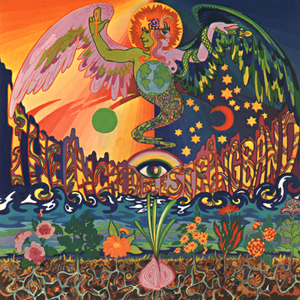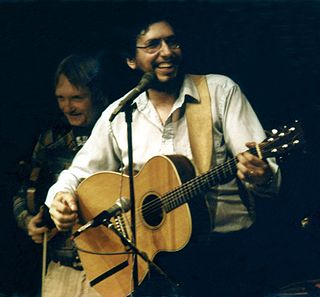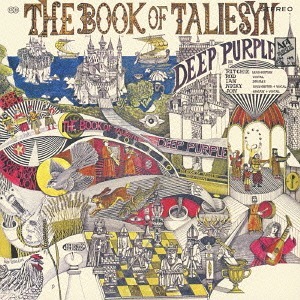Related Research Articles

Country Joe and the Fish was an American psychedelic rock band formed in Berkeley, California, in 1965. The band was among the influential groups in the San Francisco music scene during the mid- to late 1960s. Much of the band's music was written by founding members Country Joe McDonald and Barry "The Fish" Melton, with lyrics pointedly addressing issues of importance to the counterculture, such as anti-war protests, free love, and recreational drug use. Through a combination of psychedelia and electronic music, the band's sound was marked by innovative guitar melodies and distorted organ-driven instrumentals which were significant to the development of acid rock.

The Blues Magoos are an American rock group from The Bronx, a borough of New York City, United States. They were at the forefront of the psychedelic music trend, beginning in 1966. They are best known for the hit song "(We Ain't Got) Nothin' Yet", their only single to reach the Billboard top fifty.

The Waterboys are a British-Irish folk rock band formed in London in 1983 by Scottish musician and songwriter Mike Scott. The band's membership, past and present, has been composed mainly of musicians from Scotland, Ireland, Wales and England. Mike Scott has remained the only constant member throughout the band's career. They have explored a number of different styles, but their music is mainly a mix of folk music with rock and roll. They dissolved in 1993 when Scott departed to pursue a solo career. The group reformed in 2000, and continue to release albums and to tour worldwide. Scott emphasises a continuity between the Waterboys and his solo work, saying that "To me there's no difference between Mike Scott and the Waterboys; they both mean the same thing. They mean myself and whoever are my current travelling musical companions."

Tav Falco's Panther Burns, sometimes shortened to (The) Panther Burns, is a rock band originally from Memphis, Tennessee, United States, led by Tav Falco. They are best known for having been part of a set of bands emerging in the late 1970s and early 1980s who helped nationally popularize the blending of blues, country, and other American traditional music styles with rock music among groups playing in alternative music and punk music venues of the time. The earliest and most renowned of these groups to imbue these styles with expressionist theatricality and primitive spontaneity were The Cramps, largely influenced by rockabilly music. Forming just after them in 1979, Panther Burns drew on obscure country blues music, Antonin Artaud's works like The Theater and Its Double, beat poetry, and Marshall McLuhan's media theories for their early inspiration. Alongside groups like The Cramps and The Gun Club, Panther Burns is also considered a representative of the Southern Gothic-tinged roots music revival scene.

Shades of Deep Purple is the debut album by the English rock band Deep Purple, released in July 1968 on Tetragrammaton in the United States and in September 1968 on Parlophone in the United Kingdom. The band, initially called Roundabout, was the idea of former Searchers drummer Chris Curtis, who recruited Jon Lord and Ritchie Blackmore before leaving the project. The Mk. I line-up of the band was completed by vocalist/frontman Rod Evans, along with bassist Nick Simper and drummer Ian Paice, in March 1968.

The Music Machine was an American rock band formed in Los Angeles, California in 1966. Fronted by chief songwriter and lead vocalist Sean Bonniwell, the band cultivated a characteristically dark and rebellious image reflected in an untamed musical approach. Sometimes it made use of distorted guitar lines and hallucinogenic organ parts, punctuated by Bonniwell's distinctively throaty vocals. Although they managed to attain national chart success only briefly with two singles, the Music Machine is today considered by many critics to be one of the groundbreaking acts of the 1960s. Their style is now recognized as a pioneering force in proto-punk; yet within a relatively short period of time, they began to employ more complex lyrical and instrumental arrangements that went beyond the typical garage band format.
Psychedelic folk is a loosely defined form of psychedelia that originated in the 1960s. It retains the largely acoustic instrumentation of folk, but adds musical elements common to psychedelic music.

The Holy Modal Rounders was an American folk music group, originally the duo of Peter Stampfel and Steve Weber, who formed in 1963 on the Lower East Side of New York City. Although the band was not initially successful, they quickly earned a dedicated cult following and have been retrospectively praised for their pioneering innovation in several genres related to folk music. They also proved to be influential, both during their initial run and to a new generation of musicians like Yo La Tengo and Espers.

The 5000 Spirits or the Layers of the Onion is the second album by the Scottish psychedelic folk group the Incredible String Band (ISB). It was released in July 1967 on Elektra Records. The album was recorded following the reformation of the band as a duo consisting of Robin Williamson and Mike Heron. Notably, the album was a change in musical direction for the two as they transitioned from their more conventional folk music structures into complex psychedelic compositions influenced by British folk and Indian music.

David Bromberg is an American multi-instrumentalist, singer, and songwriter. An eclectic artist, Bromberg plays bluegrass, blues, folk, jazz, country and western, and rock and roll. He is known for his quirky, humorous lyrics, and the ability to play rhythm and lead guitar at the same time.

The Book of Taliesyn is the second studio album by the English rock band Deep Purple, recorded only three months after Shades of Deep Purple and released by Tetragrammaton Records in October 1968, just before their first US tour. The name for the album was taken from the 14th-century Book of Taliesin.
Shockabilly was an American avant-rock band from New York City. Shockabilly released four studio albums between 1982 and 1985, displaying an experimental approach to music that encompassed influence from numerous genres. The band's line-up included Eugene Chadbourne on guitar and vocals, Mark Kramer on bass guitar and organ, and David Licht on drums.

Changing Horses is the fifth album by the Scottish psychedelic folk group, the Incredible String Band (ISB), and was released in November 1969 on Elektra Records. The album saw the group continuing their use of unique instruments while integrating a standard musical structure. In addition, the album is seen as a transitional period in which the ISB shifted in musical textures, including early utilization of electric-based instruments.
John McBain is an American musician, producer, and mastering engineer from New Jersey. He was a guitarist for Monster Magnet, Hater, and Wellwater Conspiracy, among others. He is also active as a solo artist and has contributed to The Desert Sessions.
Psychedelic music is a wide range of popular music styles and genres influenced by 1960s psychedelia, a subculture of people who used psychedelic drugs such as 5-MeO-DMT, DMT, LSD, mescaline, and psilocybin mushrooms, to experience synesthesia and altered states of consciousness. Psychedelic music may also aim to enhance the experience of using these drugs and has been found to have a significant influence on psychedelic therapy.
The Third Bardo was an American psychedelic and garage rock band from New York City, New York. Their name is a reference to the book The Tibetan Book of the Dead.

"Who Do You Love?" is a song written by American rock and roll pioneer Bo Diddley. Recorded in 1956, it is one of his most popular and enduring works. The song represents one of Bo Diddley's strongest lyrical efforts and uses a combination of hoodoo-type imagery and boasting. It is an upbeat rocker, but the original did not use the signature Bo Diddley beat rhythm.

Marcus Barkan was an American songwriter and record producer. He was also a musical director for the television show The Banana Splits Adventure Hour, which aired between September 7, 1968, and September 5, 1970, lasting two seasons, on NBC.

Psychedelic Moods is the debut album by the American psychedelic rock band, The Deep, and was released on Cameo-Parkway Records in October 1966. The album was one of the first pieces to produce a consistent psychedelic theme throughout the whole LP. All of the material featured was originally composed by the band. Despite the conflicting dates, it is sometimes considered the first album to use the term "psychedelic" in its title.

Psychedelic Psoul is an album by the American psychedelic rock band the Freak Scene, and released on Columbia Records in 1967. After the release of the pioneering album, Psychedelic Moods, five months prior, lead member Rusty Evans reassembled the studio-only group to expand on the aspects of the previous effort. Among the material, the band included abnormal sound effects, fuzz guitar motifs, and utilization of tape manipulation, which was most relevant on the instrumental piece, "Grok!". In addition, Psychedelic Psoul incorporated Middle-eastern influences, most notably in the tracks "A Million Grains of Sand,” “Rose of Smiling Faces” and “My Rainbow Life", all of which Evans first experimented with while recording the New York rock outfit, the Third Bardo.
References
- ↑ "Psychedelic Moods". cicadelic.com. Retrieved April 23, 2015.
- ↑ Richie Unterberger. "The Deep - Biography". allmusic.com. Retrieved April 23, 2015.
- 1 2 Paul Liberatore, "Artist-musician Marcus Uzilevsky, aka Rusty Evans, dies at 78", Marin Independent Journal, december 13, 2015. Retrieved 6 June 2016
- 1 2 Jason Ankeny. "Rusty Evans -Biography". allmusic.com. Retrieved April 23, 2015.
- ↑ "Psychedelic Moods A Mind Expanding Experience". discogs.com. Retrieved April 23, 2015.
- 1 2 Benes, Ross (March 12, 2014). "The First 'Psychedelic' Album Ever". Esquire. New York, NY: Hearst Communications, Inc. Retrieved December 19, 2015.
- ↑ "Embryonic Journey". lysergia.com. Retrieved April 23, 2015.
- ↑ "The Deep - Psychedelic Moods". headheritage.co.uk. Retrieved April 23, 2015.
- ↑ Vernon Joynson. "Fuzz, Acid, and Flowers: A Comprehensive Guide to American Garage, Psychedelic, and Hippie Rock".
{{cite web}}: Missing or empty|url=(help) - ↑ James Allen. "Psychedelic Psoul - Review". allmusic.com. Retrieved April 23, 2015.
- ↑ Andrea Liss, "The Art of Marcus Uzilevsky". Retrieved 10 August 2015